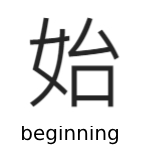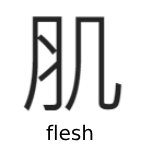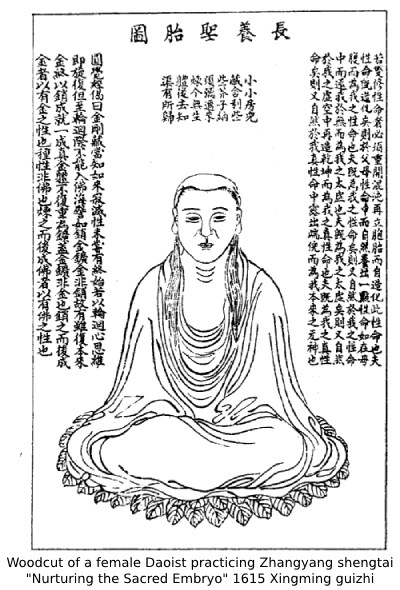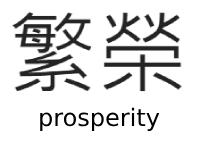Second Trimester: The Fourth Month
Second Trimester according to Classical Texts
Looking Back to Ancient Thinking

In our modern time of learning about anything, it is a simple procedure to type into a computer the desired intellectual request, and a world of knowledge is instantly presented. Today, one can easily find a plethora of cutting edge information regarding pregnancy and fetal growth. This constantly updated knowledge is relatively contemporary, and comes from scientific findings from much of the Industrialized World. To unearth the ancient Chinese thoughts regarding these same subjects is not so easy. For this reason, I share the details of these venerable beliefs, perceptions, and values of the 4th, 5th, and 6th months of gestation, so that the reader’s mind has additional insight into the complexities of these precious and powerfully formative times in human growth. These classical texts, which were presented through classes with Elisabeth Rochat De La Vallee, contain the content, systems, and language from ancient times, meaning that today’s reader must adjust to the ideas and nomenclature of long ago.
The Fourth Month

In the fourth month the ancients approached the growing human as a real fetus relative to the first trimester where the embryo was a fertile paste in the 1st month, a dot or a bulge in the 2nd month, or the start of a human in the third month. By the 4th month, the growing life in the womb was considered a real fetus with a form. The character for fetus 胎 is as ancient as the classical descriptions reviewed in this writing.
The Chinese written language is ancient, going back to the Bronze Age from approximately 3300 BC to 1200 BC. This then, lets us know that the character "fetus" was used prior to and at the same time as the classics on pregnancy and gestation were written.

When I learned about this character, it was clear that the image and what it represented said it all. The right side of the character comes from another character meaning “to begin or beginning” 始 . When we think of the classics describing the 4th month as having “form”, it is no surprise that the character for fetus, one that is just beginning its form, uses a portion of the character “to begin” on its right side. In the character “to begin”, the radical (left part) translates as “woman”. Using your imagination, it represents a woman crossing her legs. This portion of the character “to begin” is not used in the character for fetus, but it is an interesting thought to have the inclusion of “woman” as a portion of the character meaning “to begin” 女 . When we look at the left part of the character for fetus we see a simplification of the character for” flesh”, which looks like this 肌 . Putting the character “fetus” together from its separate parts, we see that it includes three concepts; a beginning, a woman, and flesh.
By the 4th month, fetal growth was described as having human shape. This recognition was most likely due to seeing and studying fetuses from miscarriage.

While observing healthy pregnancies, the ancients saw the growth and development of organs along with human shape. They also recognized the beginning of two more aspects of growth and development: meridians and spirit. This recognition is different than what the modern world perceives.
Those attending pregnant women were not able to examine, confirm, and monitor life as we do today, but with careful examinations of maternal weight, behavior, uterine growth and fetal heart rate, I am sure they knew life was underway and were able to assess the health of the mother-baby dyad. This is the method that midwives have used to assess gestational health throughout history.

Triple Warmer, Shao Yang of the Hand
According to the classics, the 4th month is supported by the Triple Warmer, the Shao Yang of the Hand.
As expressed in a previous Mayway article discussing the First Trimester, the Triple Warmer, which represents the Ministerial Fire of the Ming Men, was introduced. This Fire has two designations:
- The first designation is called the Primordial Fire; it begins at conception and continues throughout gestation. Primordial Fire is the prenatal fire.
- The second designation is called the Sovereign Fire (AKA Fire of Human), which begins at birth and remains until death. Sovereign Fire is the postnatal Fire.
In referring to the 3rd month of pregnancy, it was noted that the Pericardium/Hand Jue Yin supported gestation. In the 4th month, it is the Triple Warmer/ Hand Shao Yang that supports gestation. Both of these meridians are associated with the Fire element.
The Triple Warmer/San Jiao is a system that directs fluids and fires into the proper directions of the body, affecting all three jiaos/warmers of the body; the upper, middle, and lower. In the Nan Jing, the Triple Warmer is said to be “the pathway of water and grain and the place where Qi begins and ends”. The 4th month is therefore associated with a connection that is made everywhere in the body i.e., in all 3 jiaos, so that a synchronizing function of Blood, Qi, and Water flow smoothly to nourish fetal life. Modern Western imaging reveals that the fetus can swallow amniotic waters and pass urine by the 4th month.
During each of these two months where the Fire meridians support pregnancy (3rd and 4th), women were advised to maintain relative stillness so that the Sovereign Fire within their body would not burn too brightly, diminishing their Yin. At the same time, their relative stillness avoided the fetus’s Primordial Fire interfering with Yin.
The Mawangdui manuscript, written early in the 2nd century BCE, says:
“In the 4th month of pregnancy, (the fetus) begins to receive the essences of water to form the blood circulation. It is appropriate (for the woman) to eat rice (non-glutinous) and to drink a broth made from fish and wild goose. This is called ‘making the prosperity blossom’, to make the ear and eye communicate, and to make the meridians and connections circulate. When she washes, she must avoid cold and heat. The shao yang of the hand supports it.
Elisabeth Rochat De La Vallee adds:
The shao yang of the hand is the circulation of the triple heater, which depends internally on the fu (hollow organs). In the fourth month the child’s six fu continue their formation and this is why the shao yang of the hand supports it.....
At this time one (the woman) must take care not to disperse, otherwise she may risk problems after delivery. Why is this? Because the circulation of the Triple Heater, shao yang of the hand, depends internally on the triple heater, so she must keep her body calm, harmonize the desires and tendencies of the heart and regulate the diet.”
In the 4th month, when all the essences of the fetus have been established, the ancients speak of water. This is the first time in pregnancy that they mention any of the Five Elements. Water is the element necessary to begin all life; without its flow on the earth, nothing will grow: without its flow in the body, there is no life. Without water, there is no blood. At this time, the essence of Blood and Yin are well established, and the fetus is capable of circulating them throughout its body.
From a TCM perspective, the presence of Blood indicates that the Spleen and Heart are functioning as primordial organs. The Spleen – previously described as the hub of nutrition – is responsible for making Blood, and the Heart is responsible for circulating it. Thus, the Heart in the upper jiao, the Spleen in the middle jiao, and the Kidney (Water element) in the lower jiao represent 3 zang organs in 3 jiaos, all of which are functioning and communicating to one another. In addition, the mentioning of ears and eyes refers to Kidney and Liver, which brings an added recognition to the Liver, adding one more zang organ in the 4th month to our attention.

With current scientific knowledge regarding fetal development, at 16 weeks the skull and long bones governed by the Kidney are hardening, and the eyes governed by the Liver are moving. It is in the second trimester that fetuses see light, even though their eyelids are fused. During this 4th month, the marrow, (an outgrowth of the Kidney) is found in long bones. We also know that the red marrow contains blood stem cells that become red blood cells, as well as white blood cells and platelets.
Making the Prosperity Blossom
In the Mangwangdui, the 4th month is called “making the prosperity blossom”. Sun Sumiao, from the 6th century A.D. uses that same word “prosperity” 繁榮, calling the 4th month “making the prosperity of Blood and Qi”. In the Chinese language, the word prosperity is a character close to ying, which translates as nutrition 營養.
In our current language, the word prosperity translates as wealth, success, thriving. Of course, a miscarriage can occur at any time in pregnancy, but normally, they occur within the first trimester. If the fetus survives by the 4th month—especially by the 16th week, it is often
 perceived as a “keeper”, meaning that there is success and that the fetus is thriving. This is the month that many women who previously miscarried and held onto caution during the first 12 weeks of a subsequent pregnancy, begin to relax and let go of a heightened caution.
perceived as a “keeper”, meaning that there is success and that the fetus is thriving. This is the month that many women who previously miscarried and held onto caution during the first 12 weeks of a subsequent pregnancy, begin to relax and let go of a heightened caution.
To promote this prosperity that was written about in ancient texts, the woman is advised to behave and eat correctly for the perceived blossoming. This concept is necessary to nourish all the important areas of the body – the meridians, organs, and orifices – and nothing, including the effects of a harsh environment, should be done to hinder its proper development. For example, the mother should not expose herself to excesses such as hot or cold, but instead should strive for balance. And of course, nutrition is paramount in this month.
Foods such as non-glutinous rice, fish, and wild-goose broth benefit both the Blood and Qi. The Manwangdui tells the mother to specifically eat rice, wheat, and mud eel. The flesh of the eel is said to have an action on the blood, which for the mother and the fetus is building, circulating, and nourishing growth. Eel is high in minerals and vitamins, is a source of Omega 3 fatty acids, and it is an excellent source of protein. Since eel is found in marine waters as well as fresh waters (lakes, rivers, ponds, marshes, swamps, streams and canals), it is readily available.
During this month, the two Fire meridians connect. As already stated, in the 3rd month, it is the Pericardium that supports gestation and in the 4th month, it is the Triple Warmer. With each month, there is growth and development of one meridian until it is formed, and with that completion, the next meridian develops. When visualizing these two specific meridians, the pericardium channel begins at TianChi/PC1 close to the nipple, and descends down the inner arm ending in the center of the tip of the middle finger at Zhong Chong/PC9. Then right next to PC9, at the tip of the 4th finger, the Triple Warmer channel begins, ascending the dorsum of the arm, and traveling along the side of the neck and head, ending at Si Zhu Kong/TW 23. This growth demonstrates development and achievement, and clearly shows the relationship of these two meridians to each other.
The woman is advised to “keep her body calm to harmonize the desires and tendencies of the heart”. By keeping calm, these two fire meridians will circulate Blood and Qi so that they can connect, interact, and and nourish each other, rather than heating up and burning the Yin.
When the Manwangdui mentions the communication between the organs and the orifices (e.g., the ears and eyes), it points out the relationship and communication between the innermost parts of the body (internal organs) and the surface of it (seen through the sensory organs of the ears and eyes). This communication represents the relationship of two of the Extraordinary Eight meridians, the Yin and Yang Wei Mai. These two meridians are seen as a network of communication, communicating all the Yin and Yang within the body, but also connecting self to the outside world. This time for the fetus, then, is the very beginning of a deep connection to life.
The expectant mother opens to a new energy in the 4th month; instead of being wrapped up in herself as she was for the 1st trimester, she again experiences the outer world and relates to it fully. These relationships and connections are moving throughout her body and psyche, affecting not only her, but affecting her baby beyond the womb and to the external world.
Without this nourishing relationship between the inner and outer, the fetal senses will not properly develop and the orifices will not open: “to make the ear and eye communicate and to make the meridians and connections circulate”. When you contemplate this thought, you realize that these connections made by the woman affect her developing fetus in much the same way as they affect her. Without the nourishment of her Qi and Blood, along with the relationship she has with her external world, the fetus could suffer deficiency in both physical and social development.
Just look at the most exterior aspects of women in their 2nd trimester. Their eyes are bright and clear; their skin is soft and supple; their hair is luxurious; and they have moved from the stillness of the 1st trimester into a blossoming in the 2nd. The circulation is clearly reaching the exterior of the mother’s body as well as her spirit, and this is true for the fetus as well. Here the nourishment that is advised and the growth that is taking place affects both of them. The mother and child are not yet separate individuals, but are in a symbiotic and intimate relationship to each other, each responding to a common stimuli.
When a woman does not exhibit this richness of pregnancy, the practitioner must examine why not, and must be concerned with the normal development of the fetus. It is the power and volume of the maternal circulation of Blood and Qi that is responsible for the profusion of blood into the uterus, placenta, and fetus, and it is her shen/spirit that deepens her connection to her fetus and to her external world. Without witnessing this “prosperity” reflected in the mother, an investigation is in order.
Balance
When the mother washes, she is told to “avoid cold”, because cold will slow down, congest, or impede the proper circulation of Blood. Too much cold will affect her health as well as the development of the fetus. Likewise, to “avoid heat” is to prevent the Blood from moving too fast, causing excess heat that will diminish Yin, or increase her metabolism as well as the metabolism of her fetus. Here the mother is told she must rest – but not too much or too little! She must move – but not too much or too little. Once again, shao yang of the hand/the Triple Warmer is about balance. Any imbalance at this formative time could affect the fetus from absorbing a correct pattern of life from the choices and rhythms made by the mother. Current intelligence informs us that improper patterns of eating, sleeping and stress can affect the fetus not only in utero, but lifelong. In this ancient text, the mother is advised to always seek and maintain balance.
Shao yang of the hand represents the movement of Qi, and also the functioning of the Qi of the 6 fu organs, especially the fu of digestion, which goes both up (in the Spleen) and down (in the Stomach). This Qi has movement, but we don’t want it to have too much. A rebellious Qi of the Spleen could cause nausea or vomiting, and too much downward movement of the Stomach Qi could cause diarrhea. Both imbalances challenge the nourishment of the growing fetus. Too much upward movement can interfere with appetite, digestion, and the assimilation of nutrition, and very importantly, too much downward movement could challenge the holding aspect of the fetus’ ability to remain in the uterus, resulting in contractions or threatened miscarriage. This is especially crucial for women with history of miscarriage, and for women who are overworked, deficient, or exhausted. Any exaggerated excitement or rebellious movement is unwanted here.
The 6 fu and their continued development are mentioned. The Mawangdui states:
“In the 4th month, a child’s 6 fu – 6 hollow organs – continue their formation; and so the shao yang of the hand supports it.”
Elisabeth Rochat De La Vallee in her book Pregnancy and Gestation asks the question,
“Why do the fu appear here in the 4th month? Perhaps there is a symbolic reason because 4 is the appropriate number for forms taken on earth, and the fu deal with food coming from earth. The fu have a form, and they deal with concrete, solid forms.
Another reason is that they are to do with passage, circulation, and communication. They are seen as a set of communicating receptacles. It is important that everything passes through them correctly.
Here the triple heater is seen as being responsible for the Qi and for all the movements ensuring communication and connection, and of course there is a very strong relationship between the fu and the triple heater.
One of the main functions of the 6 fu is to act as a communication channel and passage.
In the Nanjing, the triple heater is said to have a special relation with the yang Qi and, thus, the fu. This relationship is expressed through the yuan source points on the yang meridians which are related to the Qi of the triple heater.”
Pulses
The Mawangdui says:
“When one examines the woman who is four months pregnant and wants to know if it will be a boy or a girl: if the left pulse is lively, it is a boy; if the right pulse is lively, it is a girl. If the pulses are lively on both the left and right, she will have twins.
This description of pulses has been fully confirmed in my practice. In fact, it is at least 90% accurate. It is the Spleen that creates the Blood, and that radial pulse is found on the right wrist in the middle position. The rise and fall of Blood from one month to the next is in the domain of the female gender, thus, the bigger or fuller it is, the greater the chances that the fetus is female. In contrast, if the pulses are stronger and fuller on the left, the side of Qi, the gender diagnosis is male. I have not personally noted that the 4th month is the most telling to determine gender; however, by the 4th month, one can often make a fairly accurate guess.
Despite the fact that in the 21st century most expectant parents know the gender of their fetus through ultrasound or amniocentesis, there will always be some women and couples that do not want to know the gender, but are happy to hear their practitioner’s diagnosis, which they will see as a “guess”. To them, pulses are a guess compared to the results that come from technology. What I advise to a young practitioner who wants to sharpen their pulse-taking skill is to ask the patient who already knows the gender not to mention it until the practitioner has a chance to make a diagnosis. This then allows one to hone their skill and use the mother’s information as a confirmation if the diagnosis is correct, or a chance to retake the pulse and learn the subtle differences of gender from it.
Also, when you take pulses throughout pregnancy, the gender pulse will vary, with 90 -95% of the pulses agreeing on one gender and a small portion of them not, allowing you and the parents to remain in the mystery. Remember, no test is 100% accurate. I was present for two births where repeated ultrasounds diagnosed the wrong gender, and learned of another from a midwife colleague where an amniocentesis report marked the gender incorrectly. In each instance I witnessed, the meeting of the newborn was a shock and took time to move through. In each one, there was attachment to the gender of the unborn baby, and when the different gender appeared, loss was added to shock. To the parents who had amniocentesis, there was huge shock and loss, as they had already attached to a name, painted the baby’s room pink, and had all the “wrong clothing” for their surprise son. There is something to be said about embracing the mystery of birth. When parents hear the gender diagnosis from a practitioner taking a pulse, and the diagnosis is incorrect, shock and loss do not occur, because it is easy to see that taking a pulse to determine gender can have human error.


